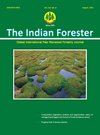Micropropagation of Pittosporum eriocarpum Royle-An Endangered and Endemic Medicinal Tree of North-West Himalaya
DOI:
https://doi.org/10.36808/if/2016/v142i8/101646Keywords:
Conservation, Pittosporum eriocarpum, Narcotic, Expectorant, Bronchitis, Micropropagation, Vermiculite.Abstract
Pittosporum eriocarpum (Pittosporaceae), commonly known as agni, is an endangered and endemic species of North-West Himalaya and facing a grim situation in the wild. Bark of the species is widely used for the preparation of traditional medicines for the treatment of narcotic, expectorant, bronchitis as well. Microprogation of the species has been carried out by using the shoot tip explant and 93.54% shooting was reported in MS medium supplemented with BAP (5.7 μM) and NAA (1.59 μM) with 24.6 average number of shoots and 5.8 cm shoot length. The in vitro regenerated shoots were shifted to the rooting medium and quarter-strength basal MS medium fortified with IBA (7.3μM) was observed as the optimum medium for the root induction and 95.78% rooting was reported with 17.4 average numbers of roots and 3.6 cm root length. After proper development of roots (3 weeks) with average root length 3.6 cm, 50 plantlets were washed properly and shifted to polythene bags containing mixture of vermiculite and soil (1:1w/v) and maintained in the green house. Initially the pots were covered by the transparent polythene bags to ensure the required humidity content and watered with 1/4 modified Hoagland's solution on alternate day. These acclimatized plants were transferred to the field with survival rate of about 84%.References
Chowdhery H.J. and Wadhwa B.M. (1984). Flora of Himachal Pradesh, Vol II. Botanical Survey of India, Calcutta.
Dhar U., Upreti J. and Bhatt I.D. (2000). Micropropagation of Pittosporum napaulensis (DC.) Rehder & Wilson – a rare, endemic Himalayan medicinal Tree, Plant Cell, Tissue and organ cult., 63: 231-235.
Duncan D.B. (1955). Multiple range and multiple F test, Biometrics, 11: 1-42.
Hajra P.K. (1983). In: An assessment of threatened plants of India. Jain, S.K. and Rao, R.R. (eds.). Botanical Survey of India, Howrah. P. 35.
Kanjilal U.N. (1928). Forest flora of Chakrata, Dehradun and Saharanpur forest Division, Uttar Pradesh. 3rd Manager of Publications, Delhi.
Osmaston A.E. (1927). A forest flora of Kumoun(reprinted 1987). International Book Distributors, Dehradun.
Rawat V.S. and Rawat Y.S. (2010). Indigenous knowledge and sustainable development in the Tones Valley of Garhwal Himalaya, J. of Medicinal Plant Research, 4(19): 2043-2047.
Singh D. and Goel R. (1999). Pittosporum eriocarpum – an endangered species with its new distribution recorded from Tehri District, Annals of Forestry, 7(2): 185-197.
Singh G. and Guru S.K. (2007). Multiple shoot induction in intact shoot tip, excised shoot tip and nodal segment explants of Rauwolfia serpentina, Indian J. Plant Physiol., 12: 360-365.
Siril E.A. and Dhar U. (1997) Micropropagation of mature Chinese Tallow tree (Sapium sebiferum), Plant Cell Rep., 16: 637–640.
Thapliyal R.C. (1994). Seed set, seed dispersal, dormancy and germination in some temperate forest species of Western Himalaya: Problems and research needs. In: Forestry Research and Education in India. Dogra. P.S. and Dhiman, R.C. (eds.) Indian National Science Academy, New Delhi.
Walter K.S. and Gillett H.J. (1998). IUCN red list of threatened plants.
Downloads
Downloads
Published
How to Cite
Issue
Section
License
Unless otherwise stated, copyright or similar rights in all materials presented on the site, including graphical images, are owned by Indian Forester.





